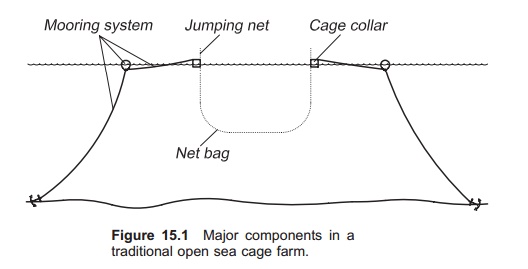Chapter: Aquaculture Engineering : Sea Cages
Sea Cages
Sea Cages
Introduction
A cage
represents a delineated volume in the body of water where the aquatic organisms
can be farmed. Cage aquaculture may date back to as early as the 1200s in some
areas of Asia, and is currently a major form of aquaculture in countries
including Canada, Chile, Japan, Norway and Scotland, where it has been
successfully used, mainly for salmonid farming. However, a large variety of
species are grown in cages today and include seawater, fresh-water and
diadromous species. Therefore today cages are used worldwide in the sea, in
lakes and large rivers.The main differences are in the size and construction
for withstanding waves and cur-rents. Trends today are that new more
weather-exposed sites are taken into use to ensure continuous growth in the
cage farming industry. The number of good sites in less exposed locations is
limited.
There are a
number of approaches to designing a cage and also classifying the various cage
systems. One classification is based on where in the water column the cage
floats. Three categories can be used: floating, submerged, or submersible. The
last two types consist of a frame that can float on the surface and that
maintains its shape when lowered below the water surface.
Another
classification is according to the type of net used in cages: rigid or
flexible. Rigid nets may be created by using a flexible net attached to a stiff
framework to distend it. Instead of using a flexible net a rigid metal net may
be used. A rigid net cage will maintain its original shape regardless of the
waves.
Instead of
using a floating construction, a fixed construction may be used. This can, for
example, bepilings driven into the seabed to which the net is then fixed to
fence in an area.
Another
classification of sea cages divides them into two categories depending on the
nature of the bag that makes up the cage; it may be an open bag of net, or a
closed bag of plastic, for instance. A closed bag will normally require water
to be pumped into it, and there is an outlet pipe from the bag. Actually, a
closed production unit has been created.
Open offshore
cages can be classified as follows:
·
Class 1 Gravity cages
that rely on buoyancy and weight to hold their shape and volume against
environmental forces
· Class 2 Anchor tension cages that rely on
the anchor tension to keep their shape and volume
· Class 3 Self-supporting cages that rely
on a combination of compression in rigid elements and tension in flexible
elements to keep the net in position so the shape and volume are maintained
· Class 4 Rigid self-supporting cages that
rely on rigid constructions such as beams and joints to keep their shape and
volume.
A traditional open cage comprises
the following main parts (Fig. 15.1):
· Net bag with
weights in the bottom to spread the bag
· A jumping net
above the surface fixed to the net bag to prevent fish escaping
· Cage collar for
spreading out the net bag and give buoyancy to keep the bag in the correct position
in the water column
· Mooring system.

When choosing technology
and systems for farming in traditionally open sea cages, there are many
conditions to be evaluated. This is also the case when the actual type of cage
and mooring system is chosen and designed. The following list can be used to
help when establishing a new sea cage farm:
·
Choose a site that is suitable for farming
·
Describe and calculate the environmental conditions
on the site
·
Choose farming systems, i.e. the cage and mooring
system, adapted to site conditions
·
Design the cages (normally done by the cage
manufacture) and mooring system
·
Set out the cages and mooring system
·
Establish requirements for operational control of the
system.
Related Topics